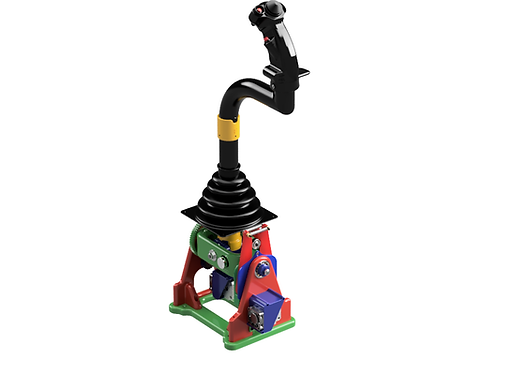
Bell 212 Heli Cyclic
This page is split into three main sections:
Parts Guide
Print Guide
Build Guide
The ultimate printer I can recommend is the Bambu Labs X1 carbon with AMS or P1P if you have deep pockets. ($1200). It's a massive leap forward in 3D printing, with excellent quality and impressive speeds. It's pretty much press print and go as the software and hardware do the calibration before each print.

This has to be one of my favourite designs to date. After working on helicopters for over 28 years, I often wondered how to reproduce the controls to make them realistic. The hardest part that any Helipilot has tried is to replicate the magnetic clutch.
I have used a stepper motor (standard Nema 17) as the mag brake, Parallel actuator, Beep trim and later on the autopilot drive unit (series Actuator).
This is NOT a force-feedback unit because helicopters do not operate like that. The control rods/cables are typically connected to servos. Due to the astronomical forces required to move the controls (between 3-20 tonnes), there are no feedback forces through the servos/controls. This is usually done by linear force feel units (springs) acting on a parallel actuator which can reset the datum point at any position. This is the purpose of the Stepper motor in this case. Most modern twin-engined rotorcraft are uncontrollable if full hydraulic servo power is lost.
This system replicates the Bell 212 cyclic forces with force trim in. Most pilots I know on the 212 like to hover, take off and land with force trim off. This makes the cyclic go completely floppy and makes controlling the aircraft easier for more extended periods of time, such as winching.
To increase the force of the cyclic, stronger springs can be added to the force feel units for those preferring a more robust resistance feel. The forces this particular cyclic replicates is that of the Bell 212HP.
This unit comes with the following:
1) A trim release switch beep trim top hat.
2) A cargo release button (not used yet but is connected).
3) An ICS/Transmit dual point trigger (not connected)
4) AFCS release button (Connected but not used yet)
At the moment, The cyclic can be repositioned in any neutral position using the trim release. Once the button is released, the cyclic will hold that position and force feel is enabled. Fine-tuning the cyclic position electrically can be used by trimming the Beep switch top hat in the direction required.
I have included a highly detailed Bell 212 cyclic grip. If you have a resin printer, I recommend using this for a smooth finish. For those that do not have access to a resin printer, I might be able to produce them for you at a cost, but this will be a limited quantity due to the time they take.
Please note: I have made the cyclic fitting 25mm so it will fit most aircraft grips, both rotary and fixed-wing. So if you have another type, it should be interchangeable.
There is no complicated software involved, just Mobiflight, and I soon hope to issue the exact file, so you do not have to programme anything. This unit replicates a standard PC joystick, using a Leo Bodnar card to keep things simple. This means it can be used on XP, DCS, P3D and MSFS!
I hope this puts a smile on your face like it did so many at the EXPO in Lelystad, including real-life pilots!
Pre-release right now while I construct the Build/Print and parts guide, which will be added here (if you want to start printing:
The build guide and components list can be found here:
https://www.737diysim.com/build-guides-1/bell-212-heli-cyclic
General Information:

